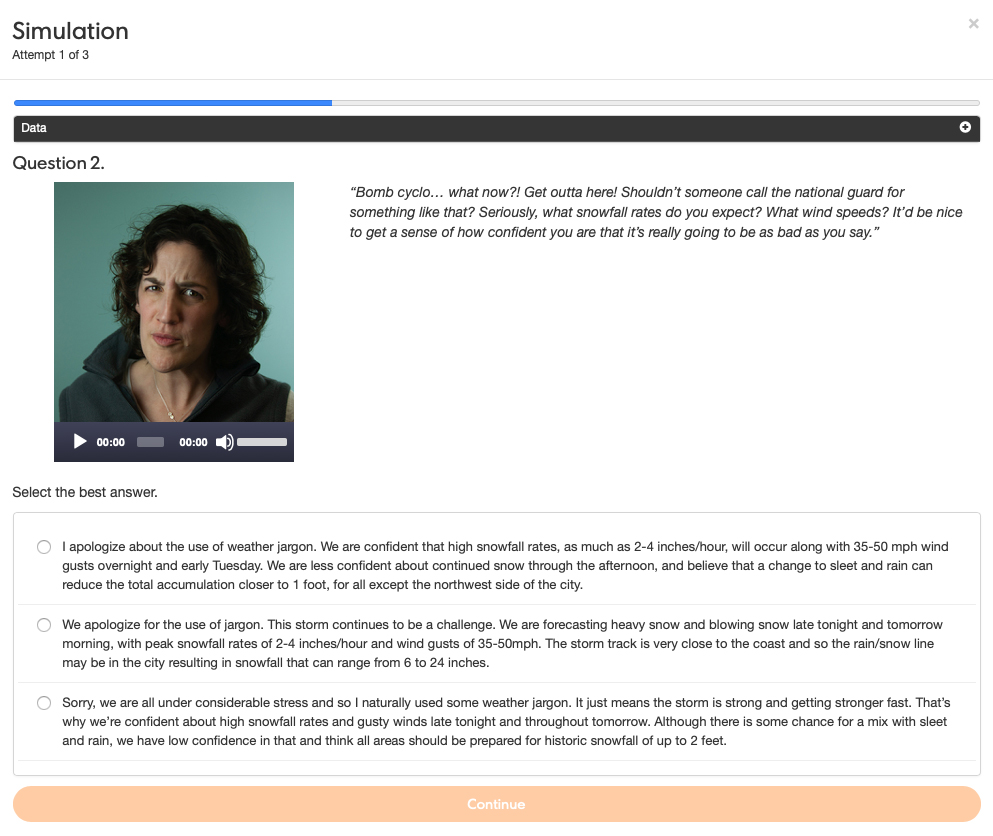Which produces better learning outcomes: classroom instruction or e-learning?
Posted on: 2020-03-27
This is a question that I encounter often in my work as an Instructional Designer for the COMET Program, especially now as the coronavirus pandemic has forced many institutions to move to online delivery of their courses. Based on my current understanding, my answer is - the instructional event that uses effective learning methods. Some of those methods include realistic decision making scenarios, spaced repetitions, real-world contexts, and feedback.
In my experience, the key method that brings them all together was summarized nicely by Michael Allen: “To learn is an action taken by and occurring within the learner. Instructors cannot learn for their learners, and neither can e-learning technology even with all its graphics, animations, effects, audio, interactivity, and so on. Learners must be active participants and, in the end, do the learning. Learner motivation determines the level of participation in learning activities and the degree to which learners will make the effort needed to learn.” (Michael Allen) I have found this to be useful for designing e-learning and classroom courses.
Our challenge as instructors is to create the conditions in which the learners will think about and take actions in order to learn. Let’s say that we are training people how to diagnose a disease in a patient. We can create a lecture about it in which the learners passively listen about how to make a diagnosis, about different symptoms and ask a few questions in the end. Or we can bring in actors who have rehearsed a list of health symptoms and then ask every learner to go through the diagnosis process and determine what kind of disease this patient has. The lecture will likely diminish motivation in the learners and the action they are taking is listening (perhaps one or two students get to ask a question). The patient simulation could increase motivation because the learners are practicing what they need to learn and they will have to use their diagnosis and communication skills. So a classroom lecture will not be enough to engage our learners in the actions to help them learn, but a classroom simulation will.
What if our budget did not allow us to create a classroom simulation? We can create an online recording of the lecture and ask the learners to view it. Based on my experience, this will also diminish learner motivation (imagine listening to a one-hour-long lecture online) and the learners will not engage in the kinds of actions that help them learn. We could create an online simulation in which learners listen to a patient, ask them questions, and then diagnose the disease. They can then receive feedback on how to improve. The learners will be thinking and taking actions to help them learn and receive feedback about their performance. The learners will be able to take the simulation at any time of the day or night and as many times as they need. This e-learning simulation will be much less expensive than the classroom simulation (no need to find actors and pay them every time, no need to deal with scheduling issues, etc.)

I hope you can see that it is possible to create ineffective and boring lectures and boring e-learning that do not create the environment for our learners to become “active participants and do the learning.” It is also possible to create engaging classroom experiences and engaging e-learning if we carefully select and adapt our instructional strategies to the learners, the topic, the budget and all the other variables that make our work so challenging.
In 2017, Will Thalheimer reviewed numerous meta-analyses comparing classroom to elearning and offered the following conclusions:
“In terms of learning effectiveness, it is NOT whether the modality is elearning or classroom instruction; the learning methods are what make the difference. Realistic decision making, spaced repetitions, real-world contexts, and feedback—among other research-supported learning factors—produce better learning than straight information presentation.”
Bernard et al. expressed a similar view after completing their impressively nuanced and detailed meta-analysis work in 2004:
“it is the characteristics of instructional design, such as the instructional strategies that are used, the feedback that is provided, and the degree of learner engagement, that create the conditions within which purposive learning will occur... Characteristics of pedagogy tended to take precedence over media... This is especially true for achievement outcomes.”
The last idea I wanted to share is about implementation. It is very rare to be successful in our first attempt of using any instructional strategy. It takes some experimentation and several iterations in order to refine our implementation to match our learners’ needs, in some instances, some learners may never be happy with our work. It is important for us to reflect after every instructional event, learn from our mistakes, find additional ideas, and try again. In this way, we are also learning how to create the conditions that help our learners become “active participants and do the learning” after every event.
My academic advisor gave me very important advice early in my training to become an Instructional Designer. He said “Designing instruction is a series of compromises. The key is to find the set of compromises that will help people learn. Choose the approach and medium that will best serve the instructional goals.” In my experience, I have found that the choices and compromises change with every audience, method, topic, budget, and delivery media.
References
Allen, M., Sites, R. (2012). Michael Allen's Guide to e-Learning: Building Interactive, Fun, and Effective Learning Programs for Any Company, 2nd Edition. ATD Press Wiley, Inc.
Bernard, R.M. Abrami, P. C. Lou, Y., Borokhovski, E., Wade, A. Wozney, L., Wallet, P. A., Fiset, M., Huang, B., (2004). How Does Distance Education Compare to Classroom Instruction? A Meta-Analysis of Empirical Literature Review of Educational Research, p. 35/63.
Thalheimer, W. (2017). Does elearning work? What the scientific research says! Available at http://www.work-learning.com/catalog.html.
This post was originally published on CALMet Commons at calmet.org.


